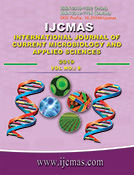


 National Academy of Agricultural Sciences (NAAS)
National Academy of Agricultural Sciences (NAAS)

|
PRINT ISSN : 2319-7692
Online ISSN : 2319-7706 Issues : 12 per year Publisher : Excellent Publishers Email : editorijcmas@gmail.com / submit@ijcmas.com Editor-in-chief: Dr.M.Prakash Index Copernicus ICV 2018: 95.39 NAAS RATING 2020: 5.38 |
In this research, two common varieties of cabbage grown in Kisii County were selected and used to evaluate and identify the availability of cabbage germplasm resistant to black rot disease. The two varieties used were Copenhagen market variety labeled as V1 and Gloria F1 Hybrid variety labelled as V2. Seeds from the two varieties were both inoculated with104 CFU/ml suspensions of Xanthomonas campestris pv. Campestris field bacterial isolates before establishing the seeds in separate Greenhouse nursery beds. The seedlings were then transplanted in to the field using a Randomized Block Design with experimental plots measuring 4 m by 3 m. Disease severity was scored on a scale of 1-9 as the plants were growing in the field, in all the four replicas and in both seasons 1 and 2. The data obtained was statistically computed by Statistical analysis system (SAS) using Analysis of Variance (ANOVA). Mean scores were compared using mean separation procedures by Least Significance Difference (LSD) and the Tukey’s multiple range test and all tests of significance were conducted at P≤ 0.05. The research findings obtained indicates that there was significant difference between the disease scores for variety1 and variety 2 in both seasons 1 and 2, and across the seasons. In summary, variety 2 had significantly (p<0.05) lower score (2.733) compared to variety 1 (3.506) and was therefore, considered as being more tolerant to black rot disease.
 |
 |
 |
 |
 |